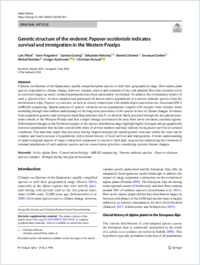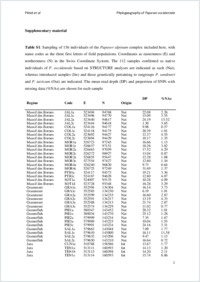Genetic structure of the endemic Papaver occidentale indicates survival and immigration in the Western Prealps
- Pittet, Loïc Department of Biology and Botanic Garden, University of Fribourg, Chemin du Musée 10, 1700 Fribourg, Switzerland
- Fragnière, Yann Department of Biology and Botanic Garden, University of Fribourg, Chemin du Musée 10, 1700 Fribourg, Switzerland
- Grünig, Sandra Institute of Plant Sciences, University of Bern, Altenbergrain 21, 3013 Bern, Switzerland
- Bétrisey, Sébastien Department of Biology and Botanic Garden, University of Fribourg, Chemin du Musée 10, 1700 Fribourg, Switzerland - Natural History Museum Fribourg, Chemin du Musée 6, 1700 Fribourg, Switzerland
- Clément, Benoît Department of Biology and Botanic Garden, University of Fribourg, Chemin du Musée 10, 1700 Fribourg, Switzerland
- Gerber, Emanuel Natural History Museum Fribourg, Chemin du Musée 6, 1700 Fribourg, Switzerland
- Ronikier, Michał W. Szafer Institute of Botany, Polish Academy of Sciences, Lubicz 46, 31‑512 Krakow, Poland
- Kozlowski, Gregor Department of Biology and Botanic Garden, University of Fribourg, Chemin du Musée 10, 1700 Fribourg, Switzerland - Natural History Museum Fribourg, Chemin du Musée 6, 1700 Fribourg, Switzerland
- Parisod, Christian Institute of Plant Sciences, University of Bern, Altenbergrain 21, 3013 Bern, Switzerland
-
30.07.2020
Published in:
- Alpine Botany. - 2020, vol. 130, no. 2, p. 129-140
English
Climatic oscillations of the Quaternary rapidly compelled plant species to shift their geographical range. How alpine plant species responded to climate change, however, remains elusive and remnants of the cold-adapted flora that currently strive in restricted ranges as small, isolated populations have been particularly overlooked. To address the evolutionary history of such a ‘glacial relict’, we here sampled and genotyped all known native populations of a narrow endemic species from the northwestern Alps, Papaver occidentale, as well as closely related taxa with double digest restriction-site Associated DNA (ddRAD) sequencing. Spatial patterns of genetic variation across populations coupled with insights from climatic niche modelling through time address underpinings of the long-term persistence of the species in face of climate changes. Evidence from population genetics and ecological modelling indicates that P. occidentale likely persisted through the last glacial maximum outside of the Western Prealps and that a major lineage recolonized the area from lower elevation, external regions. Differentiated lineages at the Northern margins of the species distribution range highlight highly divergent and geographically restricted populations that include considerable share of private markers and may indicate local glacial survival in isolated conditions. Our data thus imply that processes having shaped intraspecific spatial genetic structure within the Alps can be complex and lead to mosaic of populations with a mixed-history of local survival and immigration. A better understanding of spatio-temporal aspects of range contraction– expansion is crucial to shed light on processes underlying the evolution of remnant populations of such endemic species and set conservation priorities considering current climate changes.
- Faculty
- Faculté des sciences et de médecine
- Department
- Département de Biologie
- Language
-
- English
- Classification
- Biological sciences
- License
- License undefined
- Identifiers
-
- RERO DOC 328897
- DOI 10.1007/s00035-020-00238-3
- Persistent URL
- https://folia.unifr.ch/unifr/documents/308948
Other files
Statistics
Document views: 154
File downloads:
- koz_gde.pdf: 186
- koz_gde_sm.pdf: 136

